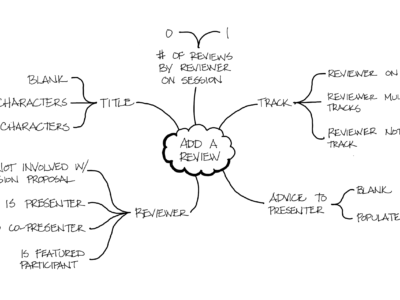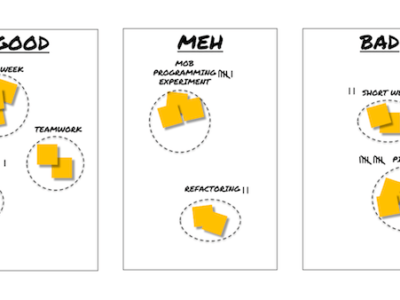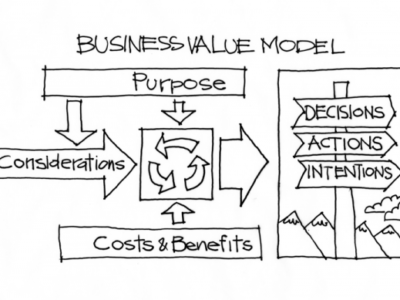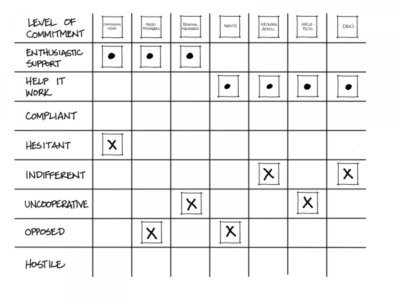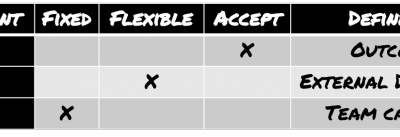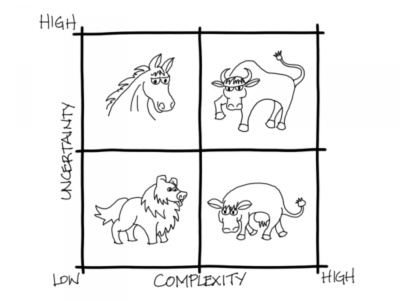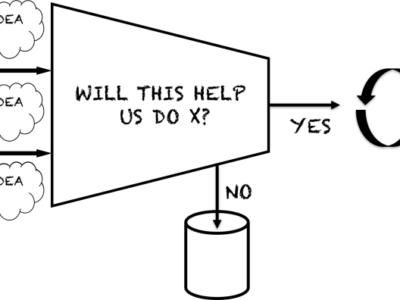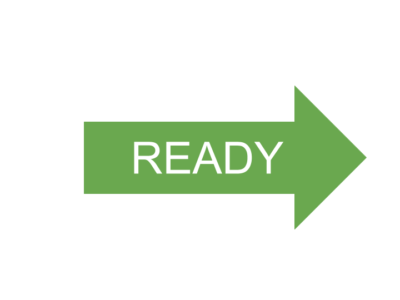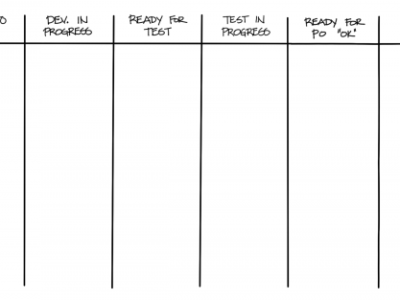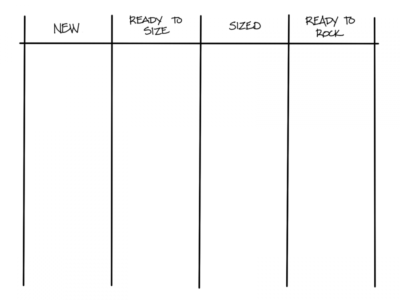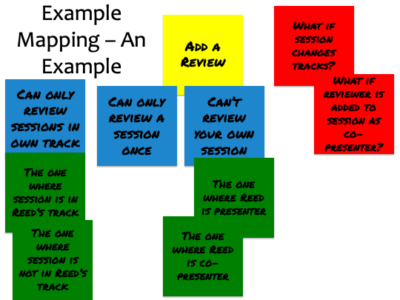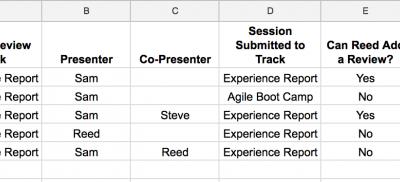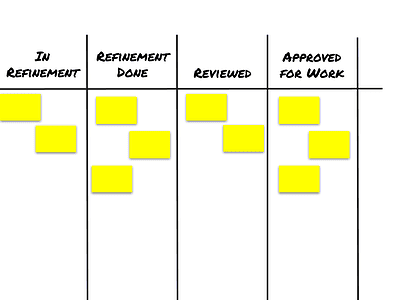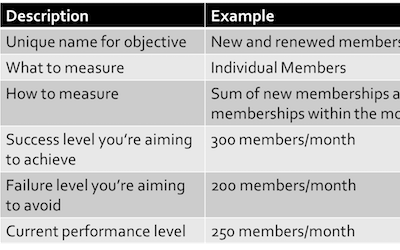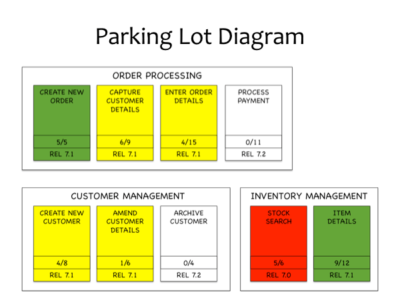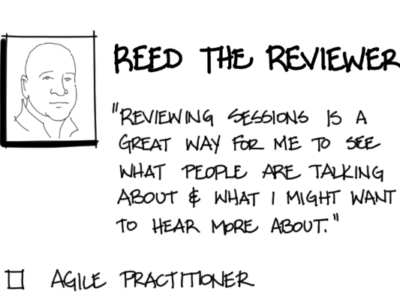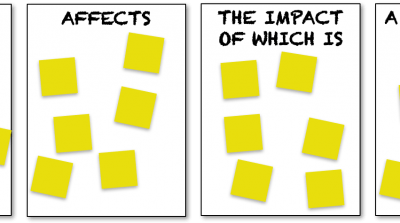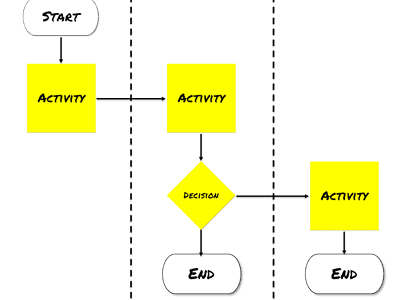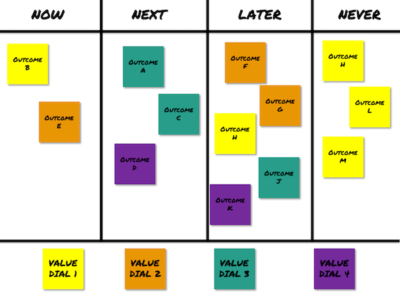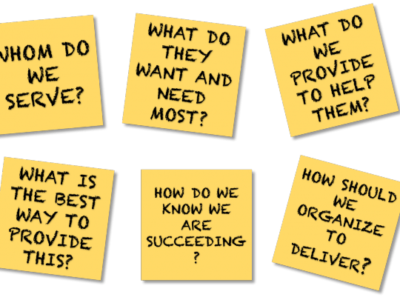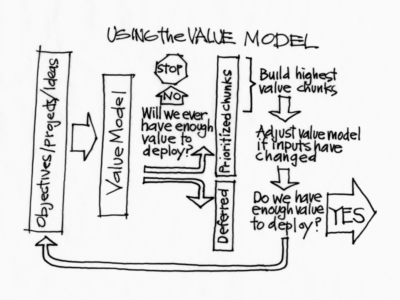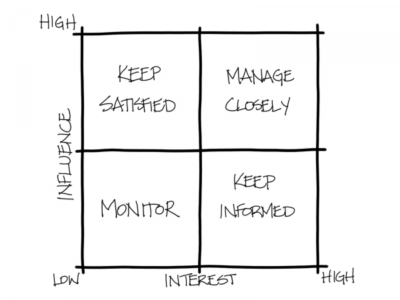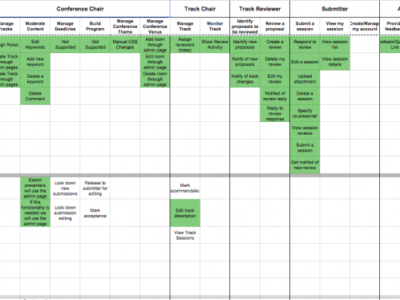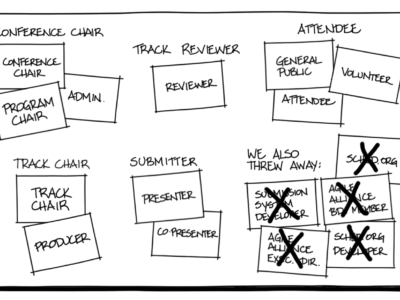In the spirit of just-in-time resources, here’s a collection of the simple, yet powerful, techniques you can use to be a more effective product person.
Acceptance Criteria
What Are Acceptance Criteria Acceptance criteria are the conditions that a solution must satisfy to be accepted by a user, a customer, or, in the case of system-level functionality, the consuming system. They are also a set of statements, each with a clear pass/fail result, that specify both functional and nonfunctional requirements and are applicable …
Action Focused Retrospectives
What are action focused retrospectives Action focused retrospectives are a way for your team to reflect on your past cycle of work, discuss what you’ve learned, identify specific action items to pursue, and follow through on those action items. Action focused retrospectives typically follow the following structure (from Agile Retrospectives by Esther Derby and Diana …
Business Value Model
Business value is a conversation, not a number. What It Is The business value model is a technique for making critical organizational decisions in an informed and timely manner. Teams using this tool identify the most critical decisions they face, determine when they need to make those decisions, and figure out which information they need …
Collaborative Modeling
What Is Collaborative Modeling Collaborative modeling refers to the use of well-known requirements analysis and modeling techniques in a collaborative fashion to build and maintain a shared understanding of the problem space and the potential solution. The main premise is that requirements models, which have long been viewed as documentation techniques, can also be put …
Commitment Scale
What Is the Commitment Scale? The commitment scale is a stakeholder analysis technique. This technique gauges the current level of stakeholder commitment to a project, as well as what level of commitment is needed to ensure the project’s success. An Example of the Commitment Scale A team working on a commission system created their stakeholder …
Constraints Matrix
It’s not quite a 2×2, but it’s still very helpful. What It Is The constraints matrix is a quick way to show the relative importance of a set of constraints facing a project team. Each row represents a general constraint faced by most teams. The most common set to use are: Cost, Time, and Scope …
Context Diagram
What is a context diagram A model that shows how your product interacts with outside people, organizations, and/or systems. The context diagram helps you to identify the interfaces you need to account for, helps you to identify scope, identify potential stakeholders, and build a better understanding of the context in which you are working. The …
Context Leadership Model
What Is The Context Leadership Model The Context Leadership Model, created by Todd Little, was introduced in Stand Back and Deliver as a tool for determining the appropriate leadership style given a product’s uncertainty and complexity. The Context Leadership Model can also be used to understand the risks inherent in a product and determine how …
Decision Filters
Organizations are impacted on a daily basis by decisions made by people at every level. Even the most minute seeming tactical decisions can have an impact on the overall organization. Successful organizations realize this and look for ways to align the decision making at all parts of the organization so that the people who are …
Definition of Done
What Is a Definition of Done The definition of done is an agreement on the set of conditions that need to be true in order to consider a backlog item done and at a point where it can deliver value to stakeholders. An Example Typical items in a definition of done include Acceptance criteria are …
Definition of Ready
What is a Definition of Ready A definition of ready is an agreement on the set of conditions that need to be true in order to consider a backlog item ready to be included in an iteration for delivery. An Example The conditions that I see included most frequently in a definition of ready are …
Delivery Board
What is a Delivery Board A delivery board is a way for a team to visualize their process for delivering functionality in a sprint. The best delivery boards consist of a whiteboard or wall divided into columns that reflect the various steps a team takes to develop and test backlog items in a sprint. The …
Discovery Board
What Is a Discovery Board Discovery boards are ways for teams to visualize their backlog refinement process. The best discovery boards consist of a whiteboard or wall divided into columns that reflect the various steps a team takes to get product backlog items ready to be delivered (developed and tested) in an iteration. The backlog …
Example Mapping
What Is Example Mapping Example Mapping is a backlog refinement technique that helps you structure your team’s conversation around a backlog item. The conversation focuses on drawing out all of the relevant acceptance criteria (or rules), related scenarios and pertinent questions associated with the backlog item you are discussing. An example mapping session identifies: An …
Examples
Examples are concrete descriptions of the expected behavior of an aspect of a solution using real-life data.
How to refine backlog items with a refinement board
A refinement board is a way for your team to visualize your backlog refinement workflow. It’s a specific form of Kanban board. The columns on the board represent the steps you follow to refine backlog items.
Impact Mapping
What Is Impact Mapping? Impact mapping combines mind mapping and strategic planning to help a team explore what behaviors they should try to influence in order to reach a particular objective. Teams use impact maps to discuss assumptions, align with organizational objectives, and develop greater focus in their projects by delivering only the things that …
Internal Product Opportunity Assessment
What Is the Internal Product Opportunity Assessment Marty Cagan in his book Inspired suggests a product opportunity assessment. Cagan’s assessment consists of ten questions to ask when examining a product opportunity to elicit more information about it and determine whether it is worth pursuing. I’ve compiled a similar list of questions for people working on …
Internal product: A guide for product people
What Is An Internal Product? An internal product is software that your organization does not offer for sale to others, but is used to support its various business activities. These products can be things your organization built in house or purchased to then customize and configure. Internal products generally satisfy the needs of users internal …
Outcome based metrics
What is an outcome based metric Outcome based metrics are a way to quantitatively tell whether you’ve delivered a particular outcome. They should measure something that has meaning to your organization’s customers or something of relevance to your organization that gives an indication that you are meeting your customer’s needs. It’s important to identify outcome …
Parking Lot Diagram
What Is a Parking Lot Diagram A parking lot diagram is a way to visually communicate status of work on a product in the context of major blocks of functionality intended to deliver a specific outcome. The parking lot diagram uses boxes to indicate the relationship between the different levels in a product functionality hierarchy, …
Personal Retrospective
What is a personal retrospective Personal retrospectives are technique that you can use to examine what happened in the past year to identify what habits you should do in the year coming up. The key is, instead of making resolutions that you’re going to break anyway, decide what habits you should adopt. When to do …
Personas
What is a Persona? A persona defines a typical user of a product. They help you understand the context in which people use the product to help guide your design decisions. Personas originated from Alan Cooper’s work on user-centered design. An Example Below is an example persona for the Agile Alliance Submission System. Reed the …
Problem Statement
What It Is The problem statement is a structured set of statements that describe the purpose of an effort in terms of what problem it’s trying to solve. An Example Since the most important part of this technique is the conversations that occur rather than the end product, I’d like to relay a story about …
Process Models
What is a process model? A process model describes the flow of work or activities, usually in a graphic format, that contribute to accomplishing a specific goal. Process models are typically used to represent and analyze a series of activities that occur repeatedly and on a regular basis. Process models can be used to model …
Product Roadmap
What is a product roadmap A product roadmap is a statement of intent for how you are going to implement your strategy. The product roadmap is a living thing that indicates your best understanding at the point that you last updated it and it also reflects whatever uncertainty you faced when you last put it …
Purpose Based Alignment Model
What is the Purpose Based Alignment Model? The Purpose Based Alignment Model, created by Niel Nickolaisen, is a method for aligning business decisions and process and feature designs around purpose. The purpose of some decisions and designs is to differentiate the organization in the market; the purpose of most other decisions is to achieve and …
Risk Management Game
What is the Risk Management Game? The risk management game is a collaborative way for your team to identify risks that you face, categorize those risks based on impact and probability, and determine which risks to address first. The game was originally created by Ken Clyne based on Steve Bockman’s Team Estimation game. Here’s an …
Six Questions
What are the Six Questions? The six questions listed below help guide your discussion about your organization’s differentiating activities. These six questions represent two different perspectives. You can use the first four questions to identify differentiating activities in your organization: 1) Whom do we serve?2) What do they want and need most?3) What do we …
Socratic Questioning
What Is Socratic Questioning Socratic questioning is a dialog structured by a series of questions intended to draw out answers. First establish a thesis of what your stakeholder thinks their need is (usually expressed as a solution). Then engage in a dialog structured as a series of questions in an attempt to refute or disprove …
Sprint Reviews
What Is A Sprint Review The Sprint Review is a discussion at the end of a sprint intended to review what the team accomplished in the sprint (including demonstrating done functionality), get feedback, and determine what, if any changes should happen in the team’s plan moving forward. These changes usually consist of revisions to the …
Stakeholder Map
What Is a Stakeholder Map The stakeholder map is a technique commonly used for stakeholder analysis. Using the stakeholder map to guide conversations helps a team understand who the stakeholders for the project are, understand key characteristics about those stakeholders, and identify plans for engaging the stakeholders on an ongoing basis. Primary outcomes from a …
Story Mapping
What Is Story Mapping A story map is a visual representation of a backlog that provides additional context regarding how backlog items are related to each other and when the team is planning to deliver them. This context is typically presented in terms of the personas that will use specific features, and the particular user …
Story Splitting
What Is Story Splitting Story splitting is the act of examining a large backlog item and splitting it into smaller backlog items that provide value and can be delivered in a short time frame. You can consider story splitting to be a planning technique that helps you organize your backlog into manageable chunks. You can …
System Documentation
What Is System Documentation System documentation is information about an as-built solution and acts as a reference for future maintenance or update efforts. It is organized based on system functionality rather than when changes were made to the system, making it easier for people who maintain the solution to find the information they need quickly. …
Usability Testing
What Is Usability Testing Usability testing is a way to test how intuitive the design, user flows and content is in your product, app or website. This form of testing consists of asking real people who are similar to potential users to perform various tasks on your product. You can use the information gained from …
User Modeling
Following is a slightly edited excerpt from Beyond Requirements: Analysis in an Agile Mindset What It Is A user is anyone who receives value from a product. Users include people who directly interact with the product as well as those who do not directly interact with the product but receive some value from it. User …
Value Based Decision Making
What Is Value Based Decision Making Value-based decision making is a method for making critical organizational decisions in an informed and timely manner. Use this tool to identify the most critical decisions you face, determine when to decide, and figure out what information you need to best make those decisions. Because critical decisions often directly …
